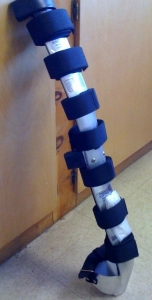Kimzey Leg Saver Splints
Currently, we are only shipping splints within the United States.
Kimzey Leg Saver Splints provide support along the front of the leg allowing immediate relief of pressure on the damaged area and quick stabilization.
The splints can be used on a front or hind leg if the leg needs to be in a “tip-toe” position. A special splint for a hind leg is available if the leg needs to be in a more natural position. The choice of which splint to use on a hind leg should be made by the veterinarian based on the injury being treated.
Comprised of aluminum with a neo-foam lining, the splints are quick and easy to apply, durable, and well tolerated by the patient. Three nylon and velcro straps secure the splint to the injured leg while a fourth strap at the base of the splint holds the hoof firmly in place.
A video demonstrating one method for applying the Kimzey Leg Saver Splint is available on YouTube.
Kimzey Leg Saver Splints are not only an aid in emergencies, but may also be used as additional support after a fiberglass cast has been applied, or left on a horse with broken sesamoid bones until they are completely healed.
The Kimzey Leg Saver Splint fills the need for satisfactory stabilization of severe injuries on the racetrack including fractures of the sesamoids, fractures of the long and short pastern bones, fractures of the cannon bone, and failure of the suspensory ligament system.
The Long Splint (top photo) is a “tip-toe” Standard, Quarter Horse, or Warm-blood Splint (see specifications below) plus a removable extension brace. With the extension brace attached, the splint can be used to treat cannon bone and knee injuries. Four connecting screws allow quick and easy conversion. Note: Standard, Quarter Horse, or Warm-blood Splints initially purchased without an extension brace will not have the screw holes necessary for attachment of the extension brace.
The smaller-scaled Foal Splint can be placed on a newborn with contracted tendons, allowing it to walk normally. After a few days the splint is removed, partially straightened (using correct straightening procedures to prevent cracking the aluminum), and placed back on the foal. After several days, the foal should be able to walk without the splint. The larger splints can also be straightened using the correct procedures.
Read about Barbaro’s experience in the New York Times.
Specifications:
When choosing the appropriate splint length, keep in mind that the top of the splint should stop below the knee.
Standard (thoroughbred) Splint has a total length of 20 inches (51 cm) with a hoof holder measuring 5 1/2 inches (14 cm) inside.
Quarter Horse Splint has a total length of 18 inches (46 cm) with a hoof holder measuring 5 1/2 inches (14 cm) inside.
Warm-blood Splint has a total length of 20 inches (51 cm) with a hoof holder measuring 6 1/4 inches (16 cm) inside.
Long Splint has the above dimensions plus 16 inches (41 cm) in length.
Foal Splint has a total length of 15 inches (38 cm) with a hoof holder measuring 3 1/4 inches (83 mm) inside.
Long Splint (Standard, Quarter Horse, or Warm-blood) US$ 587.81
Standard (thoroughbred) Splint for front or hind leg for “tip-toe” position US$ 362.04
Quarter Horse Splint for front or hind leg for “tip-toe” position US$ 362.04
Warm-blood Splint for front or hind leg for “tip-toe” position US$ 362.04
Standard (thoroughbred) Splint for hind leg (natural position) US$ 398.34
Quarter Horse Splint for hind leg (natural position) US$ 398.34
Warm-blood Splint for hind leg (natural position) US$ 398.34
Foal Splint for “tip-toe” position US$ 305.53
Above prices do not include shipping or applicable sales tax.

